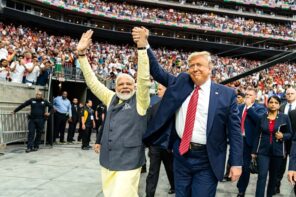Friday’s landslide election of a controversial Hindu nationalist in India culminates—or threatens to escalate—an ongoing battle over religion and the right to define the idea of the state.
Religion, a national election, and a nearly 70-year history of bitter political and social grievances seem like ingredients for a cable TV drama (or a Monty Python skit), but instead they came together in an academic-themed drama that got a lot of airtime in both Indian and American media in the past year. The story came to the forefront just before Valentine’s Day, with the withdrawal of an academic book considered an afterthought from the Indian market as a result of a lawsuit brought on by a fringe group of religious fundamentalists.
Over the past few months, the debates over Wendy Doniger’s The Hindus have largely centered around the issue of academic censorship and the rights/privileges of interpretation. Both Michael Jerryson and I had pieces that touched on that very issue, but we barely scratched the surface of why the debate has been focused on censorship rather than the content of the book itself.
The Doniger affair is actually the latest salvo in a longstanding battle within India—mostly intellectual but sometimes violent—over the definition of the secular state (and where religion fits into this concept). Censorship —or the threat of it—has become a powerful symbol in this battle. It’s too simplistic to say that it’s a Left-Right conflict, although the Indian elections helped to cast it as such. Instead, this debate has been shaped across philosophical, ideological, political religious, class, and caste lines, in which sides that have competing interests occasionally join forces or those with similar goals find themselves as enemies.
The story begins in the final years of the Indian independence movement, when the divisions among some Indian nationalist groups—particularly within the left—grew into open conflict. In 1946, a Communist-backed revolt of peasants in Telangana (which became a state called Andhra Pradesh) spilled over into post-independence India. Not only did the peasants want land reform, but they chafed under the brutal conditions of the ruling Nizam (Muslim Prince) of Hyderabad. The revolt posed a challenge for Jawaharlal Nehru, who saw the need to quash the rebellion as a means of ensuring stability for the new country.
Nehru’s decision to send the army to suppress the revolt in many ways amplified the battle over how India would define itself.
Over the next five decades until the late 1990s, India was defined by what became known as Nehruvian socialism —a country with a heavily state-regulated (and controlled) economy defined by secular ideals. However, the application of Nehruvian socialism irked Communists and Hindu nationalists equally. They both argued that the socialist state bred corruption and the gobbling up of land by Nehru’s political allies. Marxists argued that class (and to a less extent caste) were largely ignored by Indian state governments, which at the time were primarily led by Nehru’s Congress Party.
Additionally, Hindu political leaders across the philosophical and political spectrum criticized what they believed was the country’s selective secularism—appeasing and promoting religious minorities at the expense of the Hindu majority. Both sides became forceful critics of the Indian state model, but they emerged with two completely different takeaways, which would shape many of the discourses about both India and Hinduism within the country and among its expatriate population living in the West.
After the start of the Naxalite movement (which has had violent consequences in several parts of India) in the 1960s, intellectuals sympathetic to the cause began populating India’s academic institutions. What began as their critique of the oppressive Indian state—especially during the emergency rule under Indira Gandhi—morphed into criticisms of Hinduism, especially after the emergence of Ambedkarism as an occasional intellectual partner with/rival to Marxism.
Hinduism and the Indian state became one and the same for a number of academics, and, borrowing from missionary (and liberal secular) beliefs about Indian social practices and religion, they helped to advance several prominent—but false—ideas in the West: that the caste system was inherently and uniquely Hindu, that women in Hinduism are subordinate to men, and that Hinduism promoted social inequality and injustice.
In the absence of any theological perspectives, Marxist/Ambedkarist interpretations of Hinduism did have an impact on Western understandings, including those of noted religion scholars such as Doniger and Paul Courtright.
This isn’t to say that Marxist approaches to religion can’t be useful, but it’s important to understand the contexts that shaped those approaches. Additionally, the focus on deconstruction, at least within academia, occasionally aligns with Marxist critiques of religion as a tool of social oppression. This is perhaps why the most vocal Indian (or Indian expatriate) defenders of Doniger in the wake of the controversy have, for the most part, been intellectual or activist Marxists.
Penguin’s decision to withdraw her book gave them new ammo in a battle against what they perceive as Hindu majoritarian aggression, exemplified by the destruction of the Babri mosque and the 2002 Gujarat riots. Many of these intellectuals aren’t religion scholars, and it’s perhaps a fair bet to say they’re not aficionados of Doniger’s book or her past research. For some, any opportunity to criticize Hindu majoritarianism and perceived communalism is too good to pass up.
Many of these activists and scholars also live in the United States and the United Kingdom, often conjuring up fantasies of a right-wing Hindu takeover of Western institutions. Some, in the wake of the elections, have even tried to re-write history to a much more favorable interpretation of the Nehruvian model of secularism. However, they’ve remained conspicuously silent on India’s censorship of Salman Rushdie or Taslima Nasrin. Or, they have openly tried to defend their hypocrisy.
On the other side of the coin, some right-wing Hindus who felt that the Indian academy was turning anti-Hindu began their own campaigns to “right” the ship. But these activists focused on presenting a version of Hinduism in India convenient to their own social understandings, depicting an idealized Hindu society based upon patriarchy and demonstrating an intolerance towards those (religious minorities, LGBT members) who didn’t fit or buy into their model. They also sought to erase any negative depictions of certain Hindu practices, which Marxist scholars validly note as an example of cultural and historical revisionism.
Though the likes of Dinanath Batra are actually far fewer than Doniger claims or media coverage would seem to indicate, the specter of Hindu nationalism in the wake of the Penguin decision has fit conveniently into the political narrative currently dominating the country. It would be easy to compare the right-wing Hindu movement to the Christian Right in the United States or Islamist movements in Muslim-majority countries, but such a comparison is ill-fitting since the Hindu right in India isn’t as well-organized, unified, competent, or as influential as the aforementioned counterparts (nor does it actually seek to impose a Hindu theocratic state). Moreover, it obscures the complex nature to two sides that have long been critical of the Nehruvian model.
It might be said that Doniger is the only one who has the advantage in this battle, as until the Penguin India decision in February her work had not been breaking news in the academic study of Hinduism—The Hindus was the cap to an academic career rather than a bold new chapter.
In fact, what makes the aftermath of this issue so ironic is that few scholars of religion have actually defended Doniger’s controversial scholarship or endorsed her methods. The board of the American Academy of Religion, in drafting their statement of support, merely defended her right to interpret Hinduism the way she wanted. While it remains to be seen whether the controversy can bring Doniger’s research back into the forefront, one thing remains clear: the proxy war between two well-entrenched critics of the Nehruvian model of Indian governance—in India and across its Diaspora—will continue long after The Hindus fades from the headlines.




